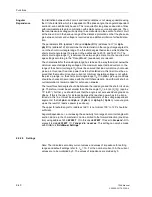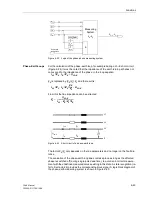
Functions
6-44
7SA6 Manual
C53000-G1176-C156-2
Figure 6-25
Logic of the phase-earth measuring system
Unfaulted Loops
The above considerations apply to the relevant short-circuited loop. A pick-up with the
current-based fault detection modes (I, U/I, U/I/
ϕ
) guarantees that only the faulty
loop(s) are released for the distance calculation. In the impedance pick-up, however,
all six loops are calculated, the impedances of the healthy loops are also influenced
by the fault currents and voltages in the short-circuited phases. During a L1–E fault for
example, the fault current in phase L1 also appears in the measuring loops L1-L2 and
L3-L1. The earth current is also measured in the loops L2–E and L3–E. Combined with
load currents which may flow, the unfaulted loops produce the so-called “apparent im-
pedances“, which have nothing to do with the actual fault distance.
These “apparent impedances” in the unfaulted loops are usually larger than the short-
circuit impedance of the faulted loop because the unfaulted loop only carries a part of
the fault current and always has a higher voltage than the faulted loop. For the selec-
tivity of the zones, the “apparent impedances” are therefore of no consequence.
Apart from the zone selectivity, the phase selectivity is also important to achieve cor-
rect identification of the faulted phases, required to alarm the faulted phase and espe-
cially to enable single-pole automatic reclosure. Depending on the infeed conditions,
close-in short circuits may cause unfaulted loops to “see” the fault further away than
the faulted loop, but still within the tripping zone. This would cause three-pole tripping
and therefore void the possibility of single-pole automatic reclosure. As a result power
transfer via the line would be lost.
In the 7SA6 this is avoided by the implementation of a loop verification function which
operates in two steps:
Initially, the calculated loop impedances and its components (phase and/or earth) are
used to simulate a replica of the line impedance. If this simulation returns a plausible
line image, the corresponding loop pick-up is designated as a definitely valid loop.
If the impedances of more than one loop are now located within the range of the zone,
the smallest is still declared to be a valid loop. Furthermore, all loops that have an im-
pedance which does not exceed the smallest loop impedance by more than 50 % are
declared as being valid. Loops with larger impedance are eliminated. Those loops
which were declared as being valid in the initial stage, cannot be eliminated by this
stage, even if they have larger impedances.
In this manner unfaulted “apparent impedances” are eliminated on the one hand, while
on the other hand, unsymmetrical multi-phase faults and multiple short circuits are rec-
ognized correctly.
The loops that were designated as being valid are converted to phase information so
that the fault detection correctly alarms the faulted phases.
I
Lx
I
E
I
Lx
>
&
measuring
syst.
L
x
–E
from state
recognition
R
x–E
; X
x–E
U
Lx
I
EP
earth fault
recognition
1202
Iph>
(parallel line)
Summary of Contents for siprotec 7SA6
Page 2: ...Siemens Aktiengesellschaft Book No C53000 G1176 C156 2 ...
Page 18: ...xviii 7SA6 Manual C53000 G1176 C156 2 ...
Page 32: ...Introduction 1 14 7SA6 Manual C53000 G1176 C156 2 ...
Page 82: ...Hardware and Connections 2 50 7SA6 Manual C53000 G1176 C156 2 ...
Page 119: ...SIPROTEC 4 Devices 4 25 7SA6 Manual C53000 G1176 C156 2 Figure 4 20 CFC Logic example ...
Page 190: ...Configuration 5 62 7SA6 Manual C53000 G1176 C156 2 ...
Page 652: ...Installation and Commissioning 8 78 7SA6 Manual C53000 G1176 C156 2 ...
Page 724: ...Technical Data 10 56 7SA6 Manual C53000 G1176 C156 ...
Page 800: ...Appendix A 76 7SA6 Manual C53000 G1176 C156 2 ...
Page 866: ...Appendix B 66 7SA6 Manual C53000 G1176 C156 2 ...












































